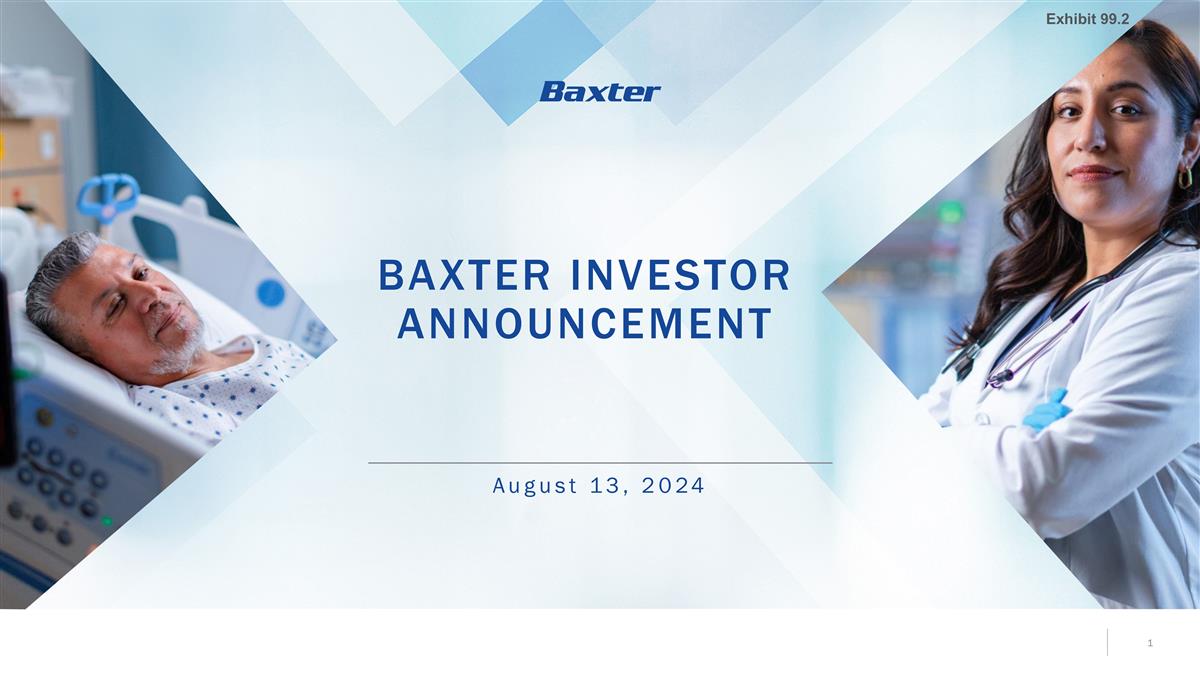
Baxter Investor Announcement August 13, 2024 Exhibit 99.2
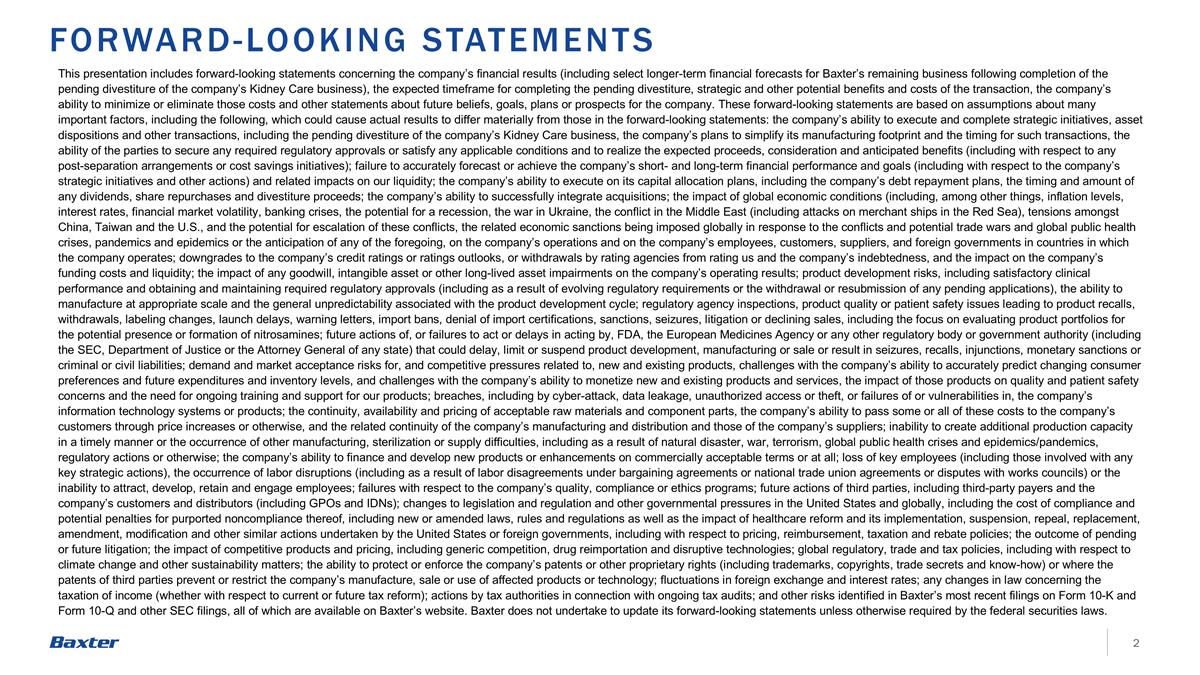
Forward-Looking Statements This presentation includes forward-looking statements concerning the company’s financial results (including select longer-term financial forecasts for Baxter’s remaining business following completion of the pending divestiture of the company’s Kidney Care business), the expected timeframe for completing the pending divestiture, strategic and other potential benefits and costs of the transaction, the company’s ability to minimize or eliminate those costs and other statements about future beliefs, goals, plans or prospects for the company. These forward-looking statements are based on assumptions about many important factors, including the following, which could cause actual results to differ materially from those in the forward-looking statements: the company’s ability to execute and complete strategic initiatives, asset dispositions and other transactions, including the pending divestiture of the company’s Kidney Care business, the company’s plans to simplify its manufacturing footprint and the timing for such transactions, the ability of the parties to secure any required regulatory approvals or satisfy any applicable conditions and to realize the expected proceeds, consideration and anticipated benefits (including with respect to any post-separation arrangements or cost savings initiatives); failure to accurately forecast or achieve the company’s short- and long-term financial performance and goals (including with respect to the company’s strategic initiatives and other actions) and related impacts on our liquidity; the company’s ability to execute on its capital allocation plans, including the company’s debt repayment plans, the timing and amount of any dividends, share repurchases and divestiture proceeds; the company’s ability to successfully integrate acquisitions; the impact of global economic conditions (including, among other things, inflation levels, interest rates, financial market volatility, banking crises, the potential for a recession, the war in Ukraine, the conflict in the Middle East (including attacks on merchant ships in the Red Sea), tensions amongst China, Taiwan and the U.S., and the potential for escalation of these conflicts, the related economic sanctions being imposed globally in response to the conflicts and potential trade wars and global public health crises, pandemics and epidemics or the anticipation of any of the foregoing, on the company’s operations and on the company’s employees, customers, suppliers, and foreign governments in countries in which the company operates; downgrades to the company’s credit ratings or ratings outlooks, or withdrawals by rating agencies from rating us and the company’s indebtedness, and the impact on the company’s funding costs and liquidity; the impact of any goodwill, intangible asset or other long-lived asset impairments on the company’s operating results; product development risks, including satisfactory clinical performance and obtaining and maintaining required regulatory approvals (including as a result of evolving regulatory requirements or the withdrawal or resubmission of any pending applications), the ability to manufacture at appropriate scale and the general unpredictability associated with the product development cycle; regulatory agency inspections, product quality or patient safety issues leading to product recalls, withdrawals, labeling changes, launch delays, warning letters, import bans, denial of import certifications, sanctions, seizures, litigation or declining sales, including the focus on evaluating product portfolios for the potential presence or formation of nitrosamines; future actions of, or failures to act or delays in acting by, FDA, the European Medicines Agency or any other regulatory body or government authority (including the SEC, Department of Justice or the Attorney General of any state) that could delay, limit or suspend product development, manufacturing or sale or result in seizures, recalls, injunctions, monetary sanctions or criminal or civil liabilities; demand and market acceptance risks for, and competitive pressures related to, new and existing products, challenges with the company’s ability to accurately predict changing consumer preferences and future expenditures and inventory levels, and challenges with the company’s ability to monetize new and existing products and services, the impact of those products on quality and patient safety concerns and the need for ongoing training and support for our products; breaches, including by cyber-attack, data leakage, unauthorized access or theft, or failures of or vulnerabilities in, the company’s information technology systems or products; the continuity, availability and pricing of acceptable raw materials and component parts, the company’s ability to pass some or all of these costs to the company’s customers through price increases or otherwise, and the related continuity of the company’s manufacturing and distribution and those of the company’s suppliers; inability to create additional production capacity in a timely manner or the occurrence of other manufacturing, sterilization or supply difficulties, including as a result of natural disaster, war, terrorism, global public health crises and epidemics/pandemics, regulatory actions or otherwise; the company’s ability to finance and develop new products or enhancements on commercially acceptable terms or at all; loss of key employees (including those involved with any key strategic actions), the occurrence of labor disruptions (including as a result of labor disagreements under bargaining agreements or national trade union agreements or disputes with works councils) or the inability to attract, develop, retain and engage employees; failures with respect to the company’s quality, compliance or ethics programs; future actions of third parties, including third-party payers and the company’s customers and distributors (including GPOs and IDNs); changes to legislation and regulation and other governmental pressures in the United States and globally, including the cost of compliance and potential penalties for purported noncompliance thereof, including new or amended laws, rules and regulations as well as the impact of healthcare reform and its implementation, suspension, repeal, replacement, amendment, modification and other similar actions undertaken by the United States or foreign governments, including with respect to pricing, reimbursement, taxation and rebate policies; the outcome of pending or future litigation; the impact of competitive products and pricing, including generic competition, drug reimportation and disruptive technologies; global regulatory, trade and tax policies, including with respect to climate change and other sustainability matters; the ability to protect or enforce the company’s patents or other proprietary rights (including trademarks, copyrights, trade secrets and know-how) or where the patents of third parties prevent or restrict the company’s manufacture, sale or use of affected products or technology; fluctuations in foreign exchange and interest rates; any changes in law concerning the taxation of income (whether with respect to current or future tax reform); actions by tax authorities in connection with ongoing tax audits; and other risks identified in Baxter’s most recent filings on Form 10-K and Form 10-Q and other SEC filings, all of which are available on Baxter’s website. Baxter does not undertake to update its forward-looking statements unless otherwise required by the federal securities laws.
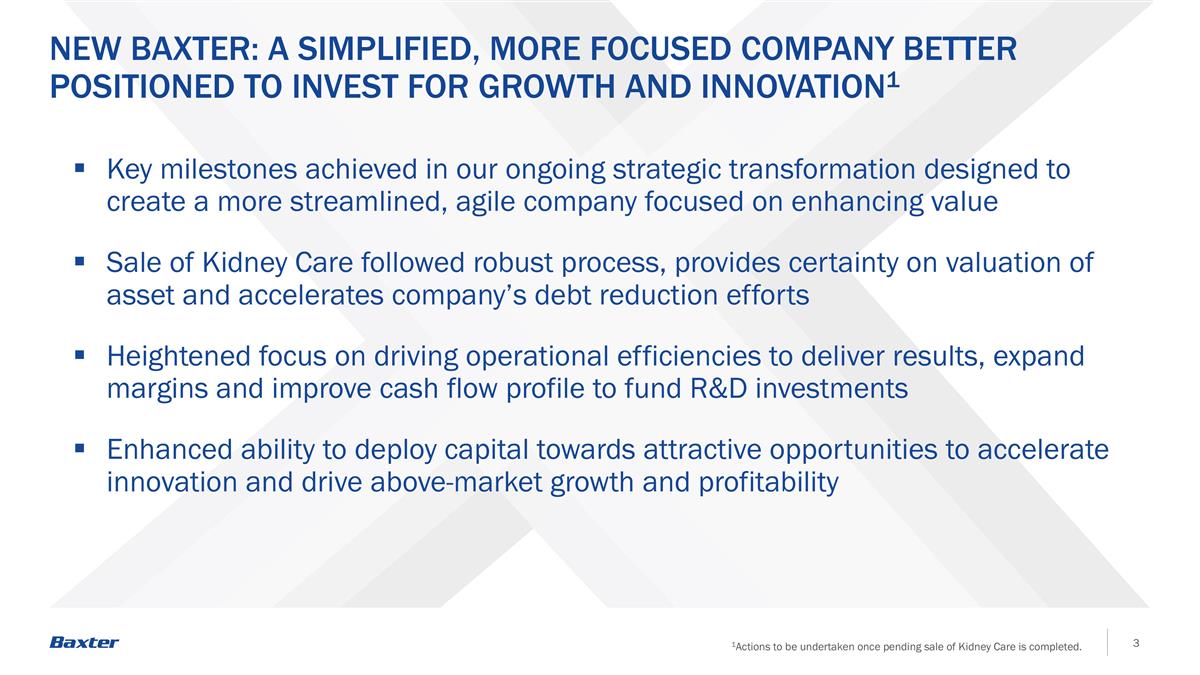
1Actions to be undertaken once pending sale of Kidney Care is completed. NEW BAXTER: A SIMPLIFIED, MORE FOCUSED COMPANY BETTER POSITIONED TO INVEST FOR GROWTH AND INNOVATION1 Key milestones achieved in our ongoing strategic transformation designed to create a more streamlined, agile company focused on enhancing value Sale of Kidney Care followed robust process, provides certainty on valuation of asset and accelerates company’s debt reduction efforts Heightened focus on driving operational efficiencies to deliver results, expand margins and improve cash flow profile to fund R&D investments Enhanced ability to deploy capital towards attractive opportunities to accelerate innovation and drive above-market growth and profitability
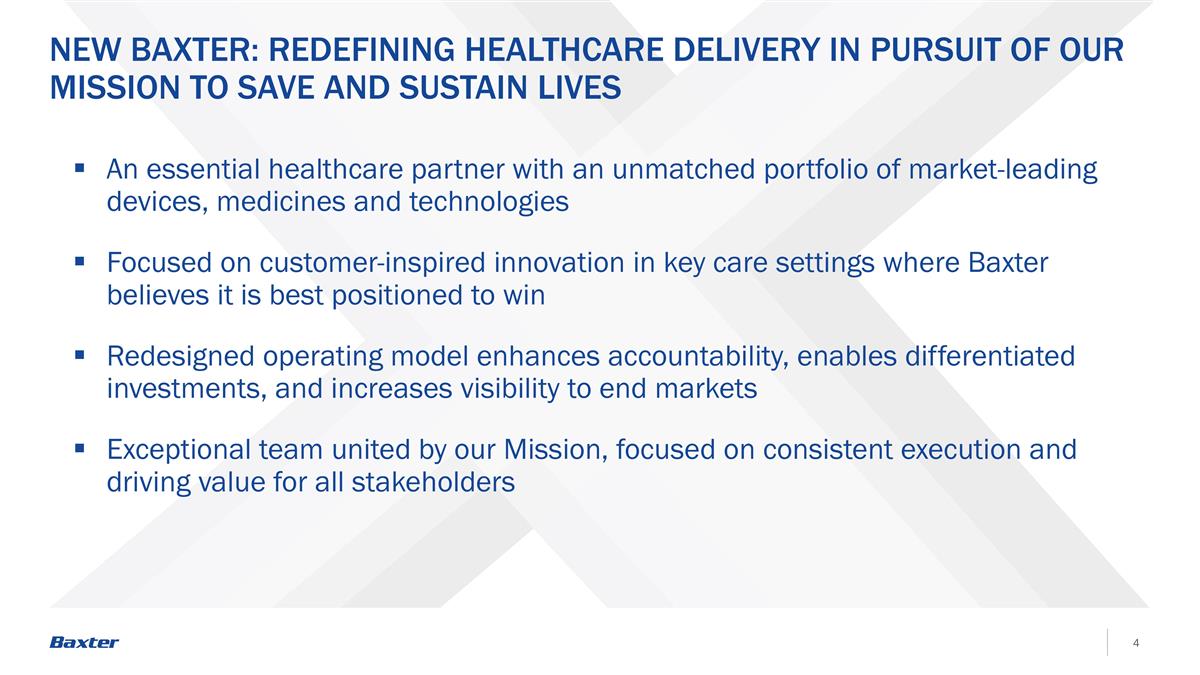
NEW BAXTER: REDEFINING HEALTHCARE DELIVERY IN PURSUIT OF OUR MISSION TO SAVE AND SUSTAIN LIVES An essential healthcare partner with an unmatched portfolio of market-leading devices, medicines and technologies Focused on customer-inspired innovation in key care settings where Baxter believes it is best positioned to win Redesigned operating model enhances accountability, enables differentiated investments, and increases visibility to end markets Exceptional team united by our Mission, focused on consistent execution and driving value for all stakeholders
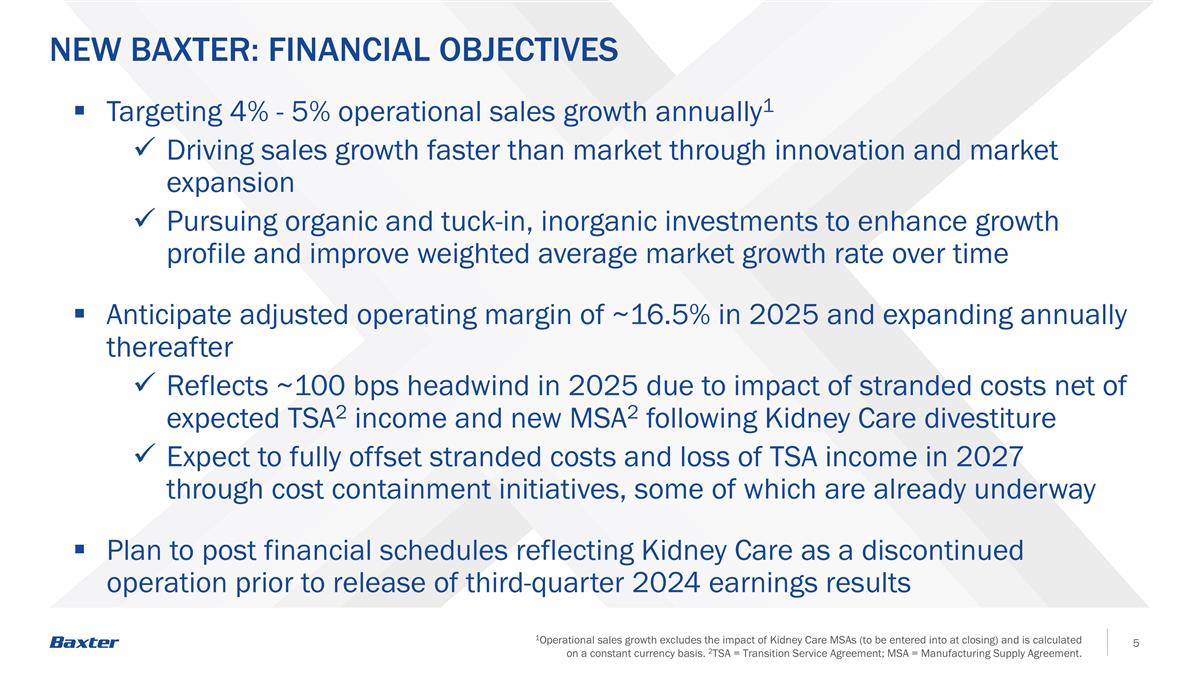
1Operational sales growth excludes the impact of Kidney Care MSAs (to be entered into at closing) and is calculated on a constant currency basis. 2TSA = Transition Service Agreement; MSA = Manufacturing Supply Agreement. NEW BAXTER: FINANCIAL OBJECTIVES Targeting 4% - 5% operational sales growth annually1 Driving sales growth faster than market through innovation and market expansion Pursuing organic and tuck-in, inorganic investments to enhance growth profile and improve weighted average market growth rate over time Anticipate adjusted operating margin of ~16.5% in 2025 and expanding annually thereafter Reflects ~100 bps headwind in 2025 due to impact of stranded costs net of expected TSA2 income and new MSA2 following Kidney Care divestiture Expect to fully offset stranded costs and loss of TSA income in 2027 through cost containment initiatives, some of which are already underway Plan to post financial schedules reflecting Kidney Care as a discontinued operation prior to release of third-quarter 2024 earnings results
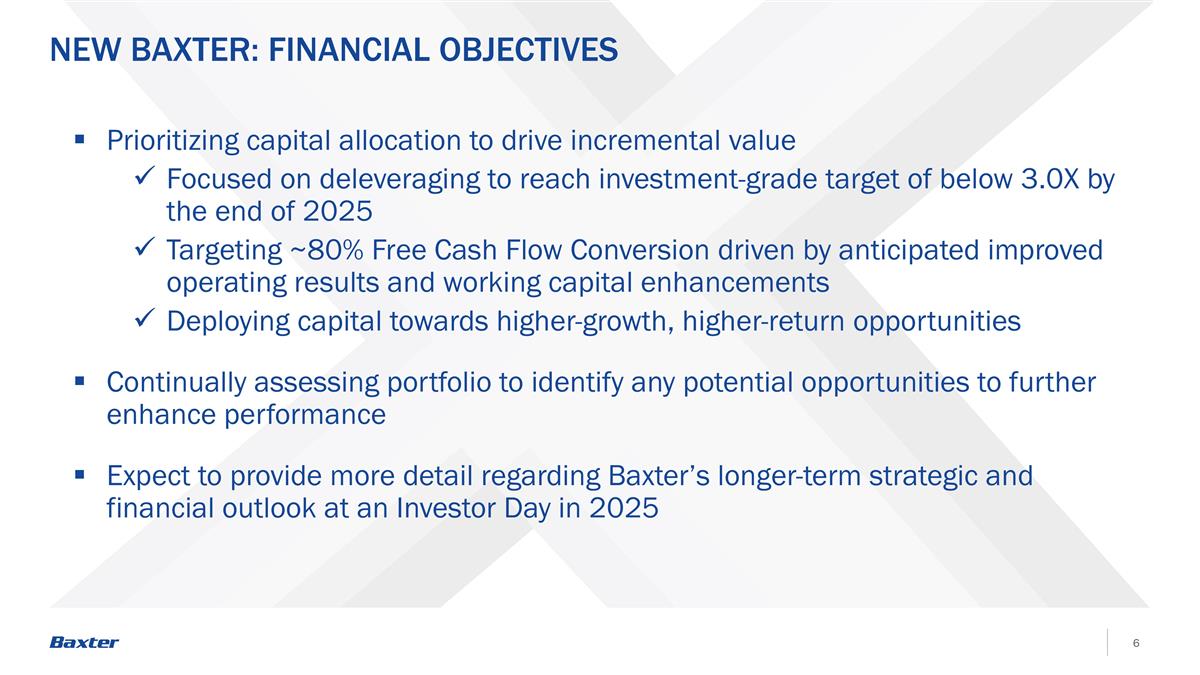
NEW BAXTER: FINANCIAL OBJECTIVES Prioritizing capital allocation to drive incremental value Focused on deleveraging to reach investment-grade target of below 3.0X by the end of 2025 Targeting ~80% Free Cash Flow Conversion driven by anticipated improved operating results and working capital enhancements Deploying capital towards higher-growth, higher-return opportunities Continually assessing portfolio to identify any potential opportunities to further enhance performance Expect to provide more detail regarding Baxter’s longer-term strategic and financial outlook at an Investor Day in 2025
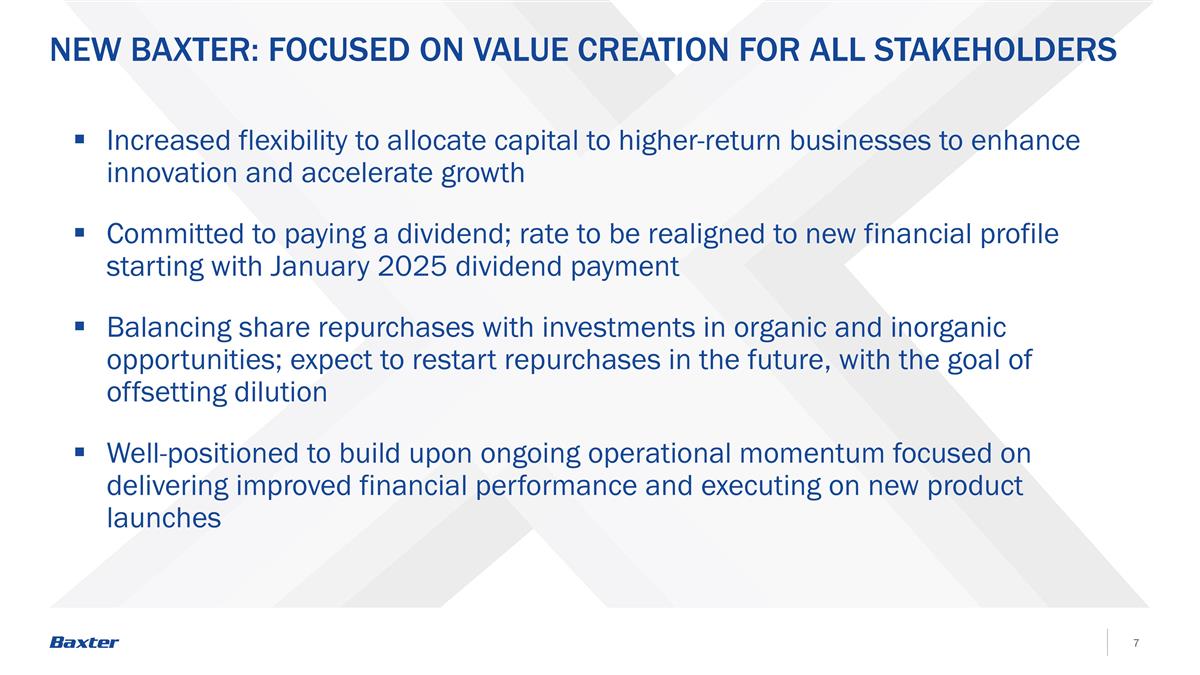
NEW BAXTER: FOCUSED ON VALUE CREATION FOR ALL STAKEHOLDERS Increased flexibility to allocate capital to higher-return businesses to enhance innovation and accelerate growth Committed to paying a dividend; rate to be realigned to new financial profile starting with January 2025 dividend payment Balancing share repurchases with investments in organic and inorganic opportunities; expect to restart repurchases in the future, with the goal of offsetting dilution Well-positioned to build upon ongoing operational momentum focused on delivering improved financial performance and executing on new product launches

NON-GAAP Reconciliations
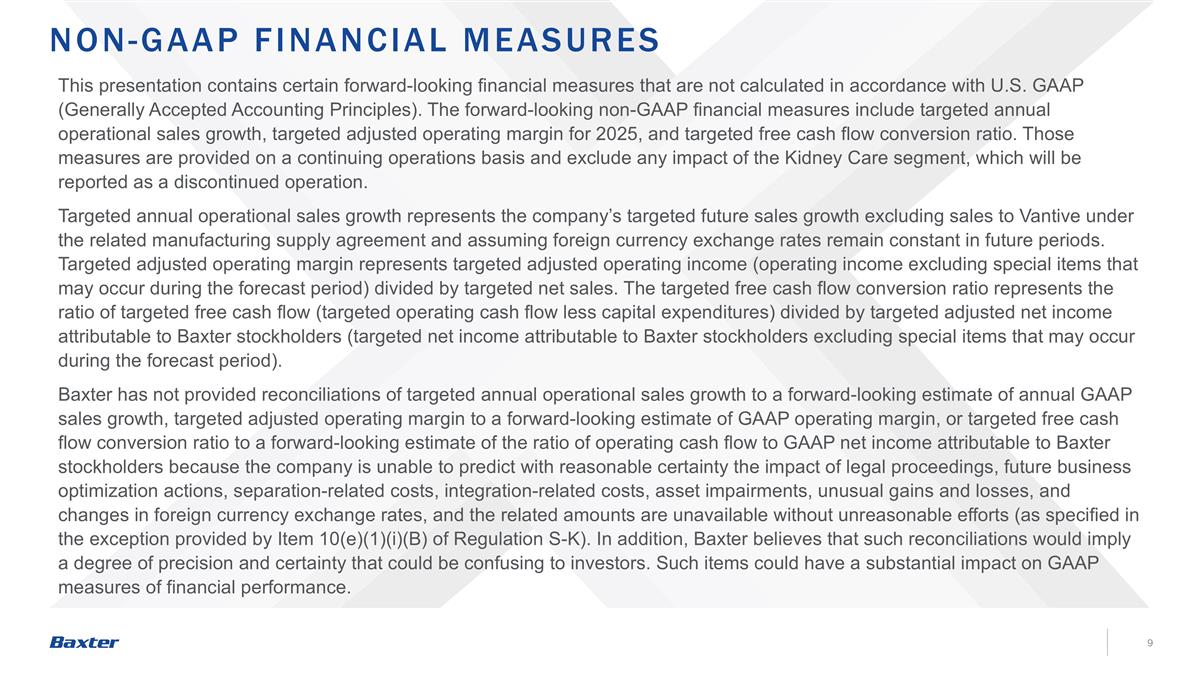
NON-GAAP FINANCIAL MEASURES This presentation contains certain forward-looking financial measures that are not calculated in accordance with U.S. GAAP (Generally Accepted Accounting Principles). The forward-looking non-GAAP financial measures include targeted annual operational sales growth, targeted adjusted operating margin for 2025, and targeted free cash flow conversion ratio. Those measures are provided on a continuing operations basis and exclude any impact of the Kidney Care segment, which will be reported as a discontinued operation. Targeted annual operational sales growth represents the company’s targeted future sales growth excluding sales to Vantive under the related manufacturing supply agreement and assuming foreign currency exchange rates remain constant in future periods. Targeted adjusted operating margin represents targeted adjusted operating income (operating income excluding special items that may occur during the forecast period) divided by targeted net sales. The targeted free cash flow conversion ratio represents the ratio of targeted free cash flow (targeted operating cash flow less capital expenditures) divided by targeted adjusted net income attributable to Baxter stockholders (targeted net income attributable to Baxter stockholders excluding special items that may occur during the forecast period). Baxter has not provided reconciliations of targeted annual operational sales growth to a forward-looking estimate of annual GAAP sales growth, targeted adjusted operating margin to a forward-looking estimate of GAAP operating margin, or targeted free cash flow conversion ratio to a forward-looking estimate of the ratio of operating cash flow to GAAP net income attributable to Baxter stockholders because the company is unable to predict with reasonable certainty the impact of legal proceedings, future business optimization actions, separation-related costs, integration-related costs, asset impairments, unusual gains and losses, and changes in foreign currency exchange rates, and the related amounts are unavailable without unreasonable efforts (as specified in the exception provided by Item 10(e)(1)(i)(B) of Regulation S-K). In addition, Baxter believes that such reconciliations would imply a degree of precision and certainty that could be confusing to investors. Such items could have a substantial impact on GAAP measures of financial performance.
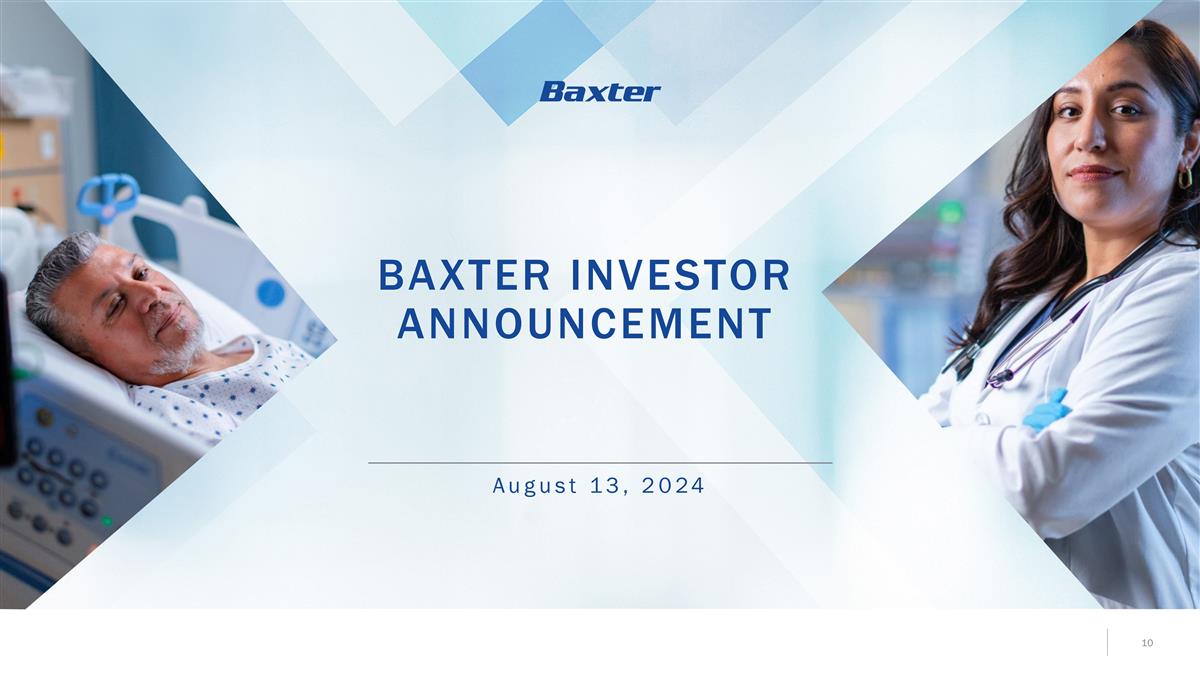
Baxter Investor Announcement August 13, 2024









